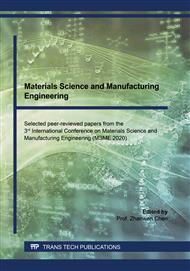p.3
p.10
p.15
p.22
p.33
p.42
p.48
p.58
Mechanical Study of Carbon Fiber Reinforced Plastic and Thin-walled Metal Liner in Bi-Material COPV Based on Grid Theory Optimization
Abstract:
Composite over-wrapped pressure vessel (COPV) with ultra-thin metal liner and high strength carbon fiber reinforced plastic (CFRP) structure was widely used in space system. Meanwhile, there are some difficulties in the calculation of COPV stress-strain state related to the elastic-plastic liner and elastic composite. In this paper a novel design theory was proposed for calculating stress distribution in the bi-material COPV and determining the optimal thickness parameters of COPV based on traditional grid theory optimization. This new theory named Parameters Correspondence Relationship Structure Design Method (PCRSDM) can increase the design precision and structure performance factor of COPV compared to traditional grid theory. The correct models of mechanical characteristic between liner and CFRP are established from the view of optimized grid theory, the present theory is useful to develop a theoretical framework to calculate and design the COPV double shells. The COPV stress-strain behavior is also systemically studied by the ANSYS finite element analysis (FEA), the results show good agreement between FEA simulation and PCRSDM calculation. Both FEA and PCRSDM can meet the design requirements of COPV. A complete design, development and qualification testing of a specialized COPV used to satellite propulsion system was successfully conducted to verify the COPV design in terms of PCRSDM and FEA, the result show that PCRSDM is suitable for the design of COPV.
Info:
Periodical:
Pages:
15-21
Citation:
Online since:
April 2021
Authors:
Price:
Сopyright:
© 2021 Trans Tech Publications Ltd. All Rights Reserved
Share:
Citation:


